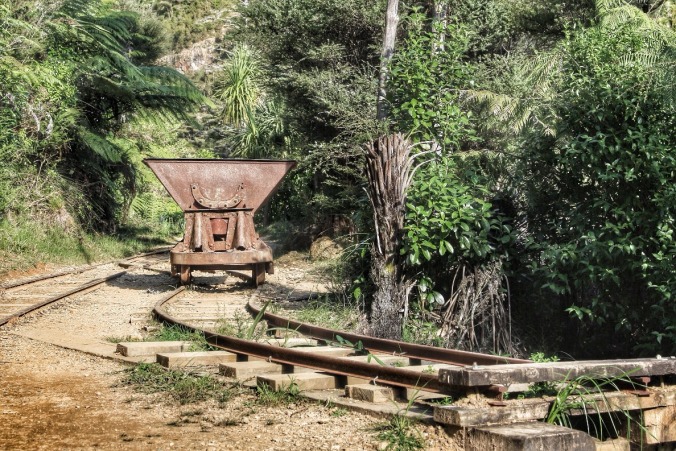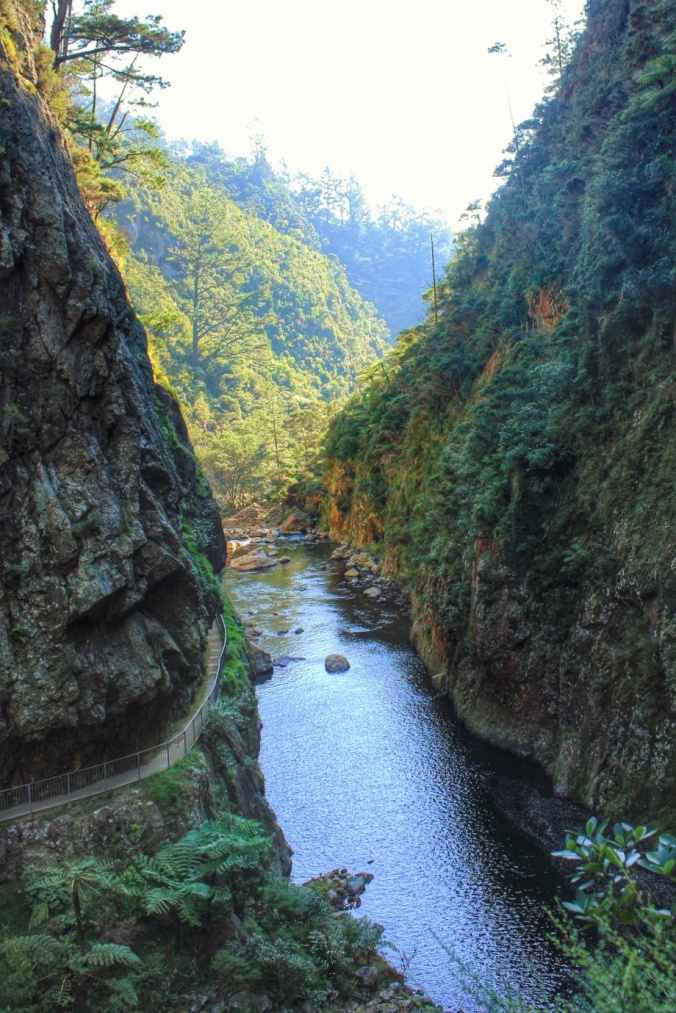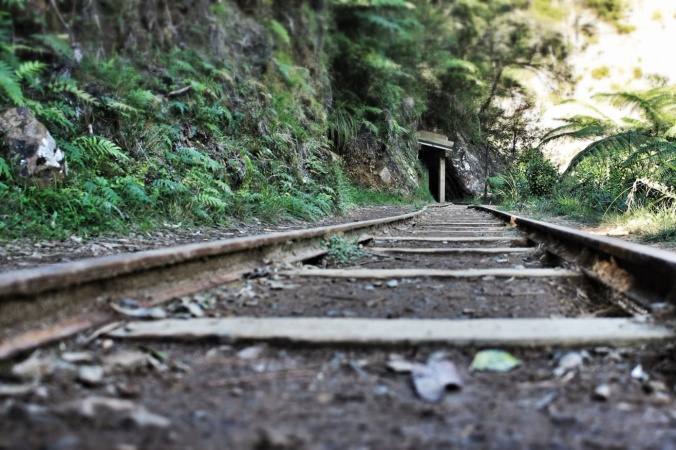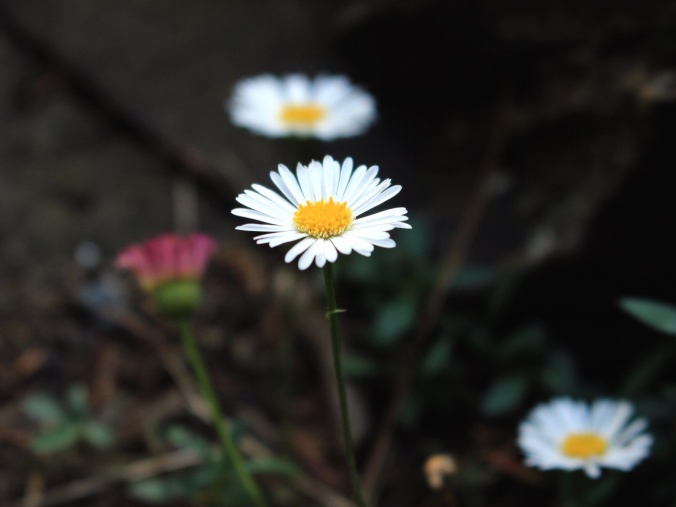
Land and sky. Perfect afternoon on the blue planet. Karangahake Gorge, Coromandel, NZ. Image: Su Leslie, 2016
The Big T and I spent yesterday afternoon at the Karangahake Gorge. About 90 minutes from Auckland at the base of the Coromandel Peninsula, the area has some fantastic walking and cycling trails that we were keen to explore.
The Karangahake Gorge is a beautiful place; a place where the flow of water over millennia has scoured the landscape and created steep valleys where light and shade play tricks at every turn.
It is also a place where humans have entered the earth in search of wealth. The rocks which line the Karangahake Gorge contain gold and silver, and were once extensively mined.
The old mines are disused now, leaving tunnels, rail lines and abandoned machinery as a reminder of how human activities change a landscape.

Disused cart for moving gold-containing quartz from mine to battery for extraction. Karangahake Gorge, Coromandel, NZ. Image: Su Leslie, 2016
All over the Earth, we see the effects of human activity; much of it damaging to ecosystems and to the planet; or at least to our tenure of it. Nature is reclaiming the Karangahake Gorge, and will undoubtedly do the same to Earth when we are gone.

While concern for human impact on the natural environment of Aotearoa-New Zealand has a long history, a defining moment came in the late 1960s, with a campaign to prevent the Manapouri Power Project raising the water levels of Lakes Manapouri and Te Anau, with devastating loss ecosystems and habitats.
‘Damn the Dam‘ by John Hanlon was released in 1973, and although it wasn’t written as a protest song, it has retrospectively come to be regarded as something of an anthem to our country’s first nationally-fought environmental campaign.
This post was written for the Daily Post Photo Challenge. The theme is Earth.



Pingback: Earth (Burst) | What's (in) the picture?
Gorge-ous! (Sorry, couldn’t resist!)
LikeLike
Hehe. 🙂
LikeLiked by 1 person
The old mine track and tunnel look just my thing….doubtless you have t hike quite a way to find them??
LikeLiked by 1 person
Actually, they have been incorporated into a few easy walks that even the relatively unfit could do. The walk we did followed the track uphill and through a series of tunnels. At some points there were “windows” in the rock where you could look down into the gorge. There are also side tunnels that can be safely explored, but we discovered that despite taking three torches, none of them actually worked very well so we kept to the main tunnels. I’m probably not explaining this very clearly: here’s a link 🙂 http://karangahakegorge.co.nz/mainpage.html
LikeLiked by 1 person
Thank you!
LikeLiked by 1 person
Happy Mother’s Day SU.
Leslie
LikeLiked by 1 person
Thank you Leslie 🙂
LikeLiked by 1 person
🙂
LikeLike
Great post! Beautiful landscape. Atmospheric abandoned mines. Touching music.
LikeLiked by 1 person
Thank you JoAnn
LikeLiked by 1 person
Lovely photos. I always thought of this song as a protest song against the dam. It really resonated with the New Zealand public
LikeLiked by 1 person
Same here. Apparently it was written as a jingle for a Pink Bats ad! But it was so popular it was sort of adopted by the Save Manapouri movement.
LikeLiked by 1 person
Will have to do that walk sometime – have driven but never stopped off for the walk
LikeLiked by 1 person
We were the same! It is really interesting. The “Windows” walk is spectacular.
LikeLiked by 1 person
The gorge is on our route home and it is a great drive. I remember the Save Manapouri campaign and thank God it worked as the lake is a real joy.
LikeLiked by 1 person
It is beautiful; and much busier than I expected. We got the last parking space. I remember ‘Damn the Dam’ but I’m not sure I really understood at the time what it was all about. The first “political” thing I really remember was when the HMNZS Otago and Canterbury sailed to Mururoa to protest the nuclear testing. That had a really big impact on me because my dad worked at the Naval Base in Devonport and we lived in Navy housing, so some of our neighbours were on-board.
LikeLike
how so very wunderful, an a happy moms week 2 U . Q
LikeLiked by 1 person
Thank you 🙂
LikeLiked by 1 person
Wow! Lovely images. First the header image was one I hadn’t seen – a bunch of bubbles – then the photos from your adventure, breathtaking. I especially love the photo of the train track leading to the mine. Great angle. The song is pretty groovy too.
LikeLike
Thank you so much. I like the train track shot too. Probably the only time I’ll ever be happy to sit on a railway line without looking over my shoulder.
LikeLiked by 1 person
It looks like such a magical place to explore. I caught my breath on the 2nd photo!
LikeLiked by 1 person
I think you’d like it. We did a couple of easy walks, but there are some spectacular longer trails, and it is part of the Hauraki Rail Trail. Lots of cyclists while we were there and they seemed to be enjoying it.
LikeLiked by 1 person
Oops: forgot the Rail Trail link: http://nzcycletrail.com/trails/hauraki-rail-trail/
LikeLike
NZ has long been on my list of places I want to go. There is simply so much wondrous splendor in such a relatively small country.
LikeLiked by 1 person
🙂 Yeah, I guess relative to Canada, we have to pack our cool stuff in pretty tight. Some of our English friends commute further for work that we travelled to get to Karangahake!
LikeLiked by 1 person